From Live Science:
1. Rolling clouds
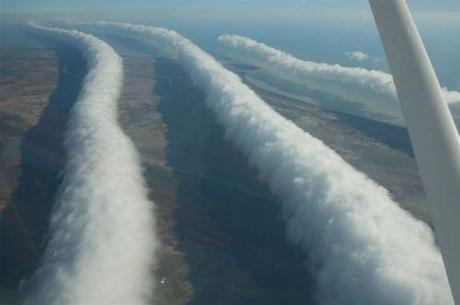
A rare tubular cloud formation occurs with regularity only one place on Earth: Northern Australia’s Gulf of Carpentaria. Here, ultra-long “roll clouds” form regularly in fall months. The phenomenon even has its own, geographically specific name, the Morning Glory cloud. Elsewhere in the world, roll clouds pop up only very occasionally, usually associated with sea winds or sometimes thunderstorm downdrafts.
2. Snow knives
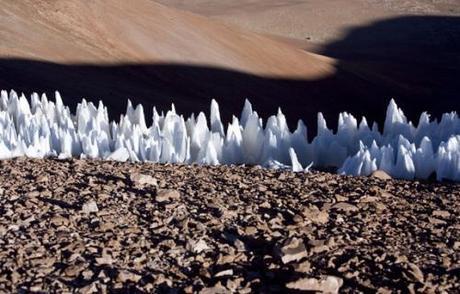
These sharp snow formations make the white stuff look uninviting. They’re called penitentes, and although they can form at high altitudes anywhere, there’s no place better to see them than in the Dry Andes of Chile and Argentina, way up past 13,000 feet. Penitentes, named after pointy hats worn by people doing penance for their sins in Christian traditions, form in very cold, dry air, where the water in snow sublimates, or turns directly into vapor without melting first. Sublimation randomly occurs faster in some areas than in others; once uneven pock-marks form in the snow, they focus the sunlight, causing those areas to sublimate ever faster. Spiky penitentes get left behind, unmelted. The tallest penitentes can reach 12 feet high.
3. Lakes that kill
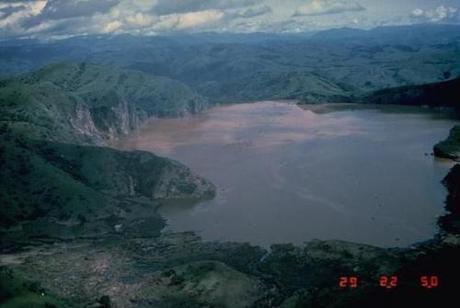
To see a lake that can kill you without you even dipping in a toe, visit Africa. In Cameroon and on the border of Rwanda and the Democratic Republic of the Congo are three deadly lakes: Nyos, Monoun and Kivu. All three are crater lakes that sit above volcanic earth. Magma below the surface releases carbon dioxide into the lakes, resulting in a deep, carbon dioxide-rich layer right above the lakebed.
In 1984, Lake Monoun abruptly exploded, releasing waves of water and a cloud of carbon dioxide. Thirty-seven people who lived near the lake asphyxiated in the CO2 cloud, though the cause of their deaths remained a mystery until two years later, when Lake Nyos let out its own burst of carbon dioxide. This time, 1,700 people died when the carbon dioxide, which is heavier than oxygen, displaced the breathable air in their villages.
Venting pipes have been installed in Lake Nyos and Lake Monoun in an attempt to release the carbon dioxide gas slowly and prevent future disasters. Kivu, which has never erupted, is not being vented, although local companies do extract dissolved methane from the lake to use for power generation.
4. Moving rocks
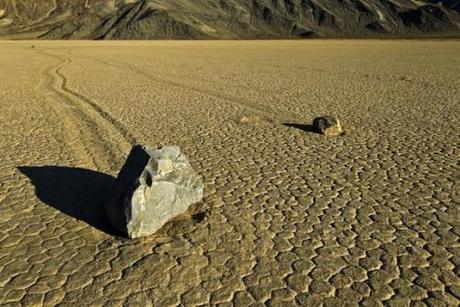
At Racetrack Playa in Death Valley, it’s not horses or stock cars that make the rounds — it’s rocks. This pancake-flat dry lakebed is marked by tracks of large rocks that seem to have wandered from here to there under their own power.
In fact, the rocks (some of which weigh tens or hundreds of pounds) may require a perfect storm to get moving. According to lunar and planetary sciences researchers at NASA Goddard, wind pushes the rocks around. But for the wind to move huge boulders, there has to be little friction between the rock and the ground. Most likely, ice-encrusted rocks get inundated by meltwater from the hills above the playa, according to NASA researchers. When everything’s nice and slick, a stiff breeze kicks up, and whoosh, the rock is off.
5. Superman’s Fortress of Solitude
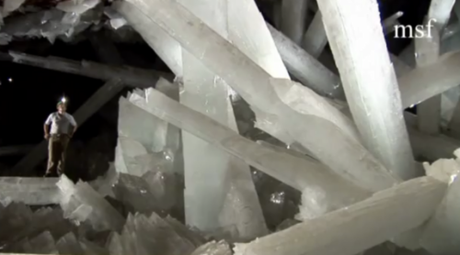
Imagine an underground world where shimmering crystals crisscross caverns like a giant’s Tinkertoys. Mexico’s Cave of Crystals, buried below the Chihuahuan desert, is just that. Here, enormous crystals of selenite grow more than 30 feet long.
But this fantasy world is tough to withstand. The cave is nearly 1,000 feet below the surface, and a magma chamber below keeps the caverns heated to about 136 degrees Fahrenheit, with 99% humidity. Explorers must wear protective gear if they hope to survive in this crystal cave for more than a few minutes.
~Eowyn

